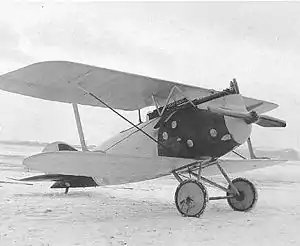Karl Meyer (aviator)
Oberflugmeister Karl Meyer was a German World War I flying ace credited with eight aerial victories. He was Germany's first naval ace, and one of the few German two-seater aces.
Karl Meyer | |
|---|---|
| Born | 29 January 1894 Mulhouse, Alsace-Lorraine, German Empire |
| Died | 31 December 1917 (aged 23) Leipzig, Germany |
| Allegiance | |
| Service/ | |
| Rank | Oberflugmeister |
| Unit | See-Flug Station 1; Marine Feld Jager 1 |
| Awards | Iron Cross |
Biography
.jpg.webp)
Karl Meyer was born on 29 January 1894 in Mulhouse, Alsace-Lorraine, then part of the German Empire. During his World War I flying service, he was attached to the Marinefliegerkorps (German Naval Air Service). His unit, See-Flug Station 1 was stationed at Zeebrugge. Its duties consisted of using seaplanes for a mixed bag of reconnaissance sorties, bombing raids on England, and aerial combat overwater.[1]
Meyer flew a Friedrichshafen FF.33 with Leutnant zur See Erich Bönisch as his aerial observer. On 17 July 1916, they shot down a French FBA flying boat. They followed that with a twin engine Caudron destroyed north of Ostend, Belgium on 2 August. Three days later, having switched mounts to Brandenburg LW, they were credited with another French FBA over Middelkerke. On 7 September 1916, they drove down a Caudron, but the victory claim was not confirmed.[1]
Having switched observers to Karl Elsasser, Meyer claimed two victories on 1 October 1916, one of which was confirmed. Meyer and Elsasser then used a Friedrichshafen FF.33 to down a FBA off Zeebrugge for his fifth confirmed victory. Karl Meyer became the German Naval Air Service's first flying ace, and one of the few German two-seater aces.[1]
On 1 February 1917, using a Rumpler D.I, Meyer drove a Sopwith Pup down into captivity at Bredene; the captured machine was subsequently given German markings.[1]

On 21 April 1917, Meyer and his observer, Oberflugmeister Kastner, were credited with bringing down Airship C.17 east of North Foreland, England. Meyer then transferred to a naval fighter unit, Marine Feld Jager 1. On 22 June, while with them, he shot down an Airco DH.4 from No. 57 Squadron RFC southwest of Diksmuide at 2145 hours.[1]
Karl Meyer returned to Sea-Flug Station 1, but scored no more. He was killed in action; however, there are differing accounts of his end. One says his Pfalz D.III fighter was shot down in flames on 12 November 1917 by Samuel Kinkead and James Henry Forman.[2] Two other sources say he died on 31 December 1917. One of these accounts states he died of injuries from an aviation accident;[1] another says he was wounded in action on 28 December and expired from his wounds on the 31st. He had been honored with the Iron Cross before his death.[3]
Sources of information
- Franks et al 1993, p. 167.
- Naval Aces of World War I, p. 51
- The Aerodrome website's page on Meyer
References
- Greg VanWyngarden, Harry Dempsey. Naval Aces of World War I. Osprey Publishing, 2011. ISBN 1849083452, ISBN 978-1849083454
- Norman Franks, Frank W. Bailey, Russell Guest. Above the Lines: The Aces and Fighter Units of the German Air Service, Naval Air Service and Flanders Marine Corps, 1914–1918. Grub Street, 1993. ISBN 0-948817-73-9, ISBN 978-0-948817-73-1.